浮动差不多介绍完了,下面截几图参考参考吧
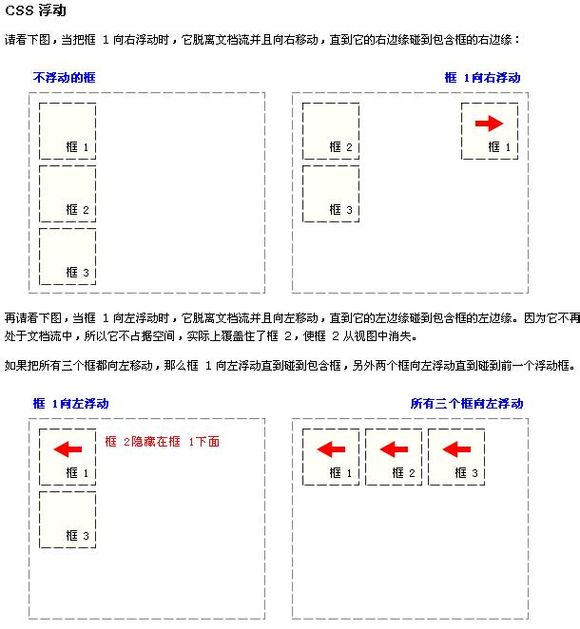
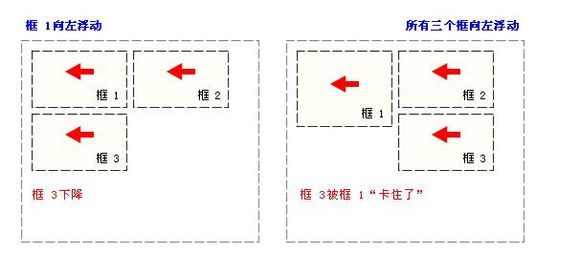
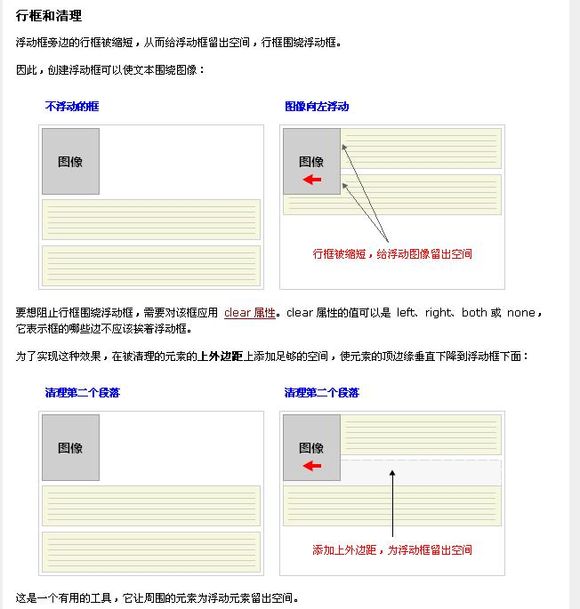
在多说一句,如果行内元素也设置float,它就自动等于是个块元素了,等于同时设置了display
下面介绍绝对定位
设置为绝对定位的元素框从文档流完全删除,并相对于其包含块定位,包含块可能是文档中的另一个元素或者是初始包含块。元素原先在正常文档流中所占的空间会关闭,就好像该元素原来不存在一样。元素定位后生成一个块级框,而不论原来它在正常流中生成何种类型的框。
绝对定位使元素的位置与文档流无关,因此不占据空间。这一点与相对定位不同,相对定位实际上被看作普通流定位模型的一部分,因为元素的位置相对于它在普通流中的位置。
概念的说法先抛在一边,简单的说
绝对定位就是不在需要margin ,float来进行定位,而是根据坐标进行定位
坐标起始点在哪,是浏览器的左上角的点
<html>
<head>
<style type="text/css">
body{
margin:0;
padding:0;
} #a{
width:500px;
height:500px;
border:solid;
margin-left:50px;
} #b{
width:100px;
height:100px;
border:soild;
background:green;
position: absolute;
left:30px;
top: 20px; } </style>
<head>
<body>
<div id="a">
<div id="b"></div> </div>
</body>
</html>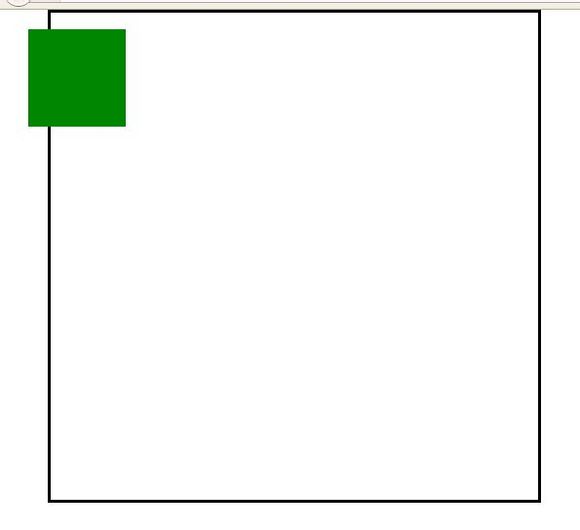
可以看出绿色并不根据他的父div来定位,而是浏览器框左上角的位置
但如果父div也定义了绝对定位或相对定位,会怎样呢?
<html>
<head>
<style type="text/css">
body{
margin:0;
padding:0;
} #a{
width:500px;
height:500px;
border:solid;
margin-left:50px;
position: absolute;
} #b{
width:100px;
height:100px;
border:soild;
background:green;
position: absolute;
left:30px;
top: 20px; } </style>
<head>
<body>
<div id="a">
<div id="b"></div> </div>
</body>
</html>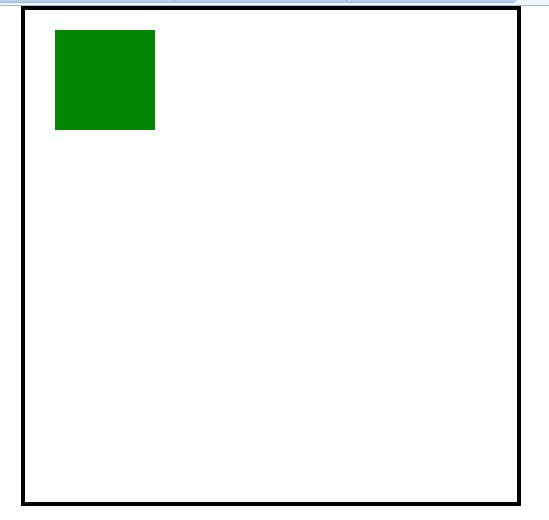
那他会根据父div的左上角来定位(父层定义position: relative;同样有效)
也就是说,如果一个定义了绝对定位的层被一个非绝对或相对定位的层包含着,是没任何意义的,它等于是一个完全独立的div,不受非绝对或相对定位的层约束
其实绝对定位比margin定位爽多了,margin定位需要拿周边的div做参照物,而绝对定位只需要根据左上角调整坐标即可
绝对定位是脱离了文本流的,它可以去任何区域,即便那区域已经有div占着了
<html>
<head>
<style type="text/css">
body{
margin:0;
padding:0;
} #a{
width:500px;
height:500px;
border:solid;
margin-left:50px;
position: relative; } #b{
width:100px;
height:100px;
border:soild;
background:green;
position: absolute;
left:30px;
top: 20px; } #c{
width:100px;
height:100px;
border:soild;
background:red; } </style>
<head>
<body>
<div id="a">
<div id="c"></div>
<div id="b"></div> </div>
</body>
</html>
可以看到它覆盖了普通div,无视了普通div的存在
那么是不是也会覆盖浮动div呢?
<html>
<head>
<style type="text/css">
body{
margin:0;
padding:0;
} #a{
width:500px;
height:500px;
border:solid;
margin-left:50px;
position: relative; } #b{
width:100px;
height:100px;
border:soild;
background:green;
position: absolute;
left:30px;
top: 20px; } #c{
width:200px;
height:200px;
border:soild;
background:red;
float:left;
margin:10px;
}
#d{
width:100px;
height:100px;
border:soild;
background:blue; } </style>
<head>
<body>
<div id="a">
<div id="c"></div>
<div id="d"></div>
<div id="b"></div> </div>
</body>
</html>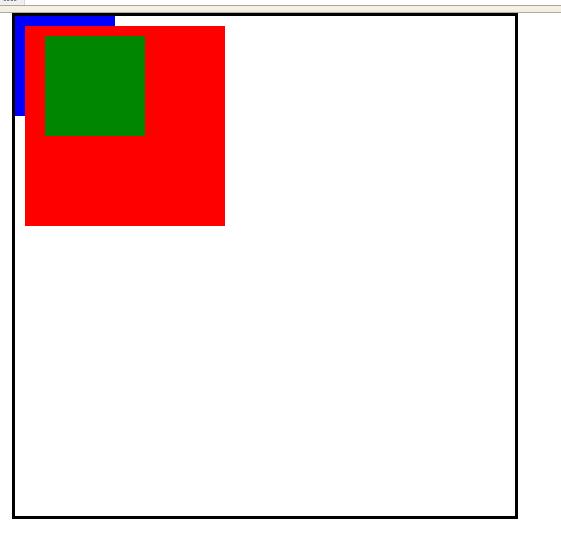
蓝色是普通div,红色是浮动div ,绿色是绝对定位div
可以看出,绝对定位div是在最高层,能覆盖所有
也就是说普通div在地上遵循地上的流模式
浮动div遵循空中的流模式,一个是地上的飞机,一个是在空中的飞机
那么绝对定位div等于是飞艇了,比飞机飞的要高,而且可以自由移动
现在看看两个绝对定位div遇到一起会怎样
<html>
<head>
<style type="text/css">
body{
margin:0;
padding:0;
} #a{
width:500px;
height:500px;
border:solid;
margin-left:50px;
position: relative; } #b{
width:100px;
height:100px;
border:soild;
background:green;
position: absolute;
left:30px;
top: 20px; } #c{
width:100px;
height:100px;
border:soild;
background:red;
position: absolute;
left:60px;
top: 20px;
}
</style>
<head>
<body>
<div id="a">
<div id="c"></div>
<div id="b"></div> </div>
</body>
</html>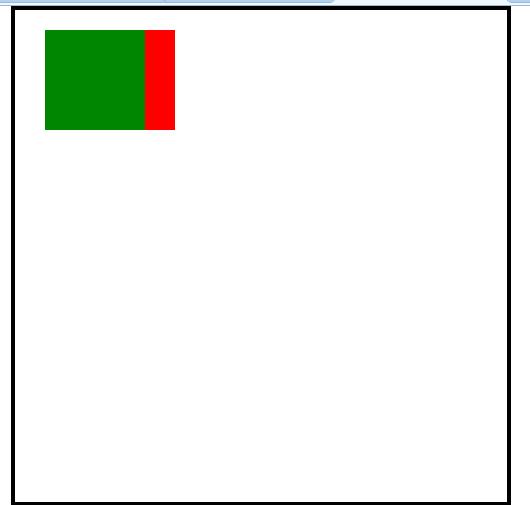
可以看到,绿色覆盖的红色,这说明两个绝对div是不会有流模式的,所以使用margin无效
他们互相都当互相不存在,才不会管哪块区域被占用
那为什么是绿色覆盖了红色,不是红色覆盖绿色?
因为这里
101c9493018144180a2afca12b3b983616b28748ea4df4d9c2150843fecfba68
420148876e501e0f862e459b487fc65f16b28748ea4df4d9c2150843fecfba68
因为红色div在前面,绿色在后,网页是按从上到下,从左到右解析的,所以解析到红色div先出现,绿色就会覆盖
总而言之,越往后的绝对定位div,等于是它飞的越高,可以覆盖掉前面的绝对定位div
你把这两个掉个头,你会发现是红色覆盖了绿色
还有一种办法,就是用z-index属性,z-index等级越高就飞的越高,不设置就默认为0
<html>
<head>
<style type="text/css">
body{
margin:0;
padding:0;
} #a{
width:500px;
height:500px;
border:solid;
margin-left:50px;
position: relative; } #b{
width:100px;
height:100px;
border:soild;
background:green;
position: absolute;
left:30px;
top: 20px; } #c{
width:100px;
height:100px;
border:soild;
background:red;
position: absolute;
left:60px;
top: 20px;
z-index:1;
}
</style>
<head>
<body>
<div id="a">
<div id="c"></div>
<div id="b"></div> </div>
</body>
</html>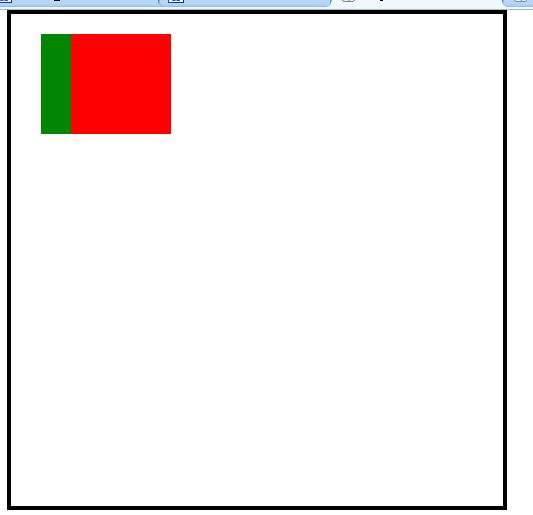
这样可以不用考虑绝对定位div的出现顺序就让他们谁在谁上面
以上就是div+css网页布局设计新开端(9)的内容,更多相关内容请关注PHP中文网(www.php.cn)!
 每周平台新闻:Galaxy Store的Web应用程序,Tappable Stories,CSS SubgridApr 14, 2025 am 11:20 AM
每周平台新闻:Galaxy Store的Web应用程序,Tappable Stories,CSS SubgridApr 14, 2025 am 11:20 AM在本周的综述中:Firefox获得了类似锁匠的力量,三星的Galaxy Store开始支持Progressive Web Apps,CSS Subgrid正在Firefox发货
 每周平台新闻:Internet Explorer模式,搜索控制台中的速度报告,限制通知提示Apr 14, 2025 am 11:15 AM
每周平台新闻:Internet Explorer模式,搜索控制台中的速度报告,限制通知提示Apr 14, 2025 am 11:15 AM在本周的综述中:Internet Explorer进入Edge,Google Search Console吹捧新的速度报告,Firefox提供了Facebook&#039;
 使用Gatsby组织和准备图像以使图像模糊效果的方法Apr 14, 2025 am 10:56 AM
使用Gatsby组织和准备图像以使图像模糊效果的方法Apr 14, 2025 am 10:56 AM盖茨比(Gatsby)进行了出色的处理和处理图像。例如,它可以帮助您节省图像优化的时间,因为您不必手动


热AI工具

Undresser.AI Undress
人工智能驱动的应用程序,用于创建逼真的裸体照片

AI Clothes Remover
用于从照片中去除衣服的在线人工智能工具。

Undress AI Tool
免费脱衣服图片

Clothoff.io
AI脱衣机

AI Hentai Generator
免费生成ai无尽的。

热门文章

热工具

VSCode Windows 64位 下载
微软推出的免费、功能强大的一款IDE编辑器

Dreamweaver CS6
视觉化网页开发工具

WebStorm Mac版
好用的JavaScript开发工具

安全考试浏览器
Safe Exam Browser是一个安全的浏览器环境,用于安全地进行在线考试。该软件将任何计算机变成一个安全的工作站。它控制对任何实用工具的访问,并防止学生使用未经授权的资源。

禅工作室 13.0.1
功能强大的PHP集成开发环境










